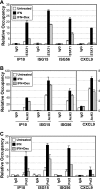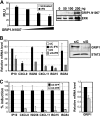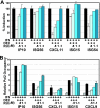The type I interferon signaling pathway is a target for glucocorticoid inhibition
- PMID: 20679482
- PMCID: PMC2950533
- DOI: 10.1128/MCB.00146-10
The type I interferon signaling pathway is a target for glucocorticoid inhibition
Abstract
Type I interferon (IFN) is essential for host defenses against viruses; however, dysregulated IFN signaling is causally linked to autoimmunity, particularly systemic lupus erythematosus. Autoimmune disease treatments rely on glucocorticoids (GCs), which act via the GC receptor (GR) to repress proinflammatory cytokine gene transcription. Conversely, cytokine signaling through cognate Jak/STAT pathways is reportedly unaffected or even stimulated by GR. Unexpectedly, we found that GR dramatically inhibited IFN-stimulated gene (ISG) expression in macrophages. The target of inhibition, the heterotrimeric STAT1-STAT2-IRF9 (ISGF3) transcription complex, utilized the GR cofactor GRIP1/TIF2 as a coactivator. Consequently, GRIP1 knockdown, genetic ablation, or depletion by GC-activated GR attenuated ISGF3 promoter occupancy, preinitiation complex assembly, and ISG expression. Furthermore, this regulatory loop was restricted to cell types such as macrophages expressing the GRIP1 protein at extremely low levels, and pharmacological disruption of the GR-GRIP1 interaction or transient introduction of GRIP1 restored RNA polymerase recruitment to target ISGs and the subsequent IFN response. Thus, type I IFN is a cytokine uniquely controlled by GR at the levels of not only production but also signaling through antagonism with the ISGF3 effector function, revealing a novel facet of the immunosuppressive properties of GCs.
Figures







Similar articles
-
Glucocorticoid-induced phosphorylation by CDK9 modulates the coactivator functions of transcriptional cofactor GRIP1 in macrophages.Nat Commun. 2017 Nov 23;8(1):1739. doi: 10.1038/s41467-017-01569-2. Nat Commun. 2017. PMID: 29170386 Free PMC article.
-
The GRIP1:IRF3 interaction as a target for glucocorticoid receptor-mediated immunosuppression.EMBO J. 2006 Jan 11;25(1):108-17. doi: 10.1038/sj.emboj.7600919. Epub 2005 Dec 15. EMBO J. 2006. PMID: 16362036 Free PMC article.
-
Interferon-alpha inhibits glucocorticoid receptor-mediated gene transcription via STAT5 activation in mouse HT22 cells.Brain Behav Immun. 2009 May;23(4):455-63. doi: 10.1016/j.bbi.2009.01.001. Epub 2009 Jan 8. Brain Behav Immun. 2009. PMID: 19167480 Free PMC article.
-
The unique role of STAT2 in constitutive and IFN-induced transcription and antiviral responses.Cytokine Growth Factor Rev. 2016 Jun;29:71-81. doi: 10.1016/j.cytogfr.2016.02.010. Epub 2016 Mar 18. Cytokine Growth Factor Rev. 2016. PMID: 27053489 Review.
-
How glucocorticoid receptors modulate the activity of other transcription factors: a scope beyond tethering.Mol Cell Endocrinol. 2013 Nov 5;380(1-2):41-54. doi: 10.1016/j.mce.2012.12.014. Epub 2012 Dec 23. Mol Cell Endocrinol. 2013. PMID: 23267834 Review.
Cited by
-
Human adenovirus infections: update and consideration of mechanisms of viral persistence.Curr Opin Infect Dis. 2018 Jun;31(3):251-256. doi: 10.1097/QCO.0000000000000451. Curr Opin Infect Dis. 2018. PMID: 29601326 Free PMC article. Review.
-
Role of transcriptional coregulator GRIP1 in the anti-inflammatory actions of glucocorticoids.Proc Natl Acad Sci U S A. 2012 Jul 17;109(29):11776-81. doi: 10.1073/pnas.1206059109. Epub 2012 Jul 2. Proc Natl Acad Sci U S A. 2012. PMID: 22753499 Free PMC article.
-
Management of Adenoviral Keratoconjunctivitis: Challenges and Solutions.Clin Ophthalmol. 2020 Mar 17;14:837-852. doi: 10.2147/OPTH.S207976. eCollection 2020. Clin Ophthalmol. 2020. PMID: 32256043 Free PMC article. Review.
-
A pharmacoproteomic landscape of organotypic intervention responses in Gram-negative sepsis.Nat Commun. 2023 Jun 17;14(1):3603. doi: 10.1038/s41467-023-39269-9. Nat Commun. 2023. PMID: 37330510 Free PMC article.
-
Nuclear receptors in inflammation control: repression by GR and beyond.Mol Cell Endocrinol. 2013 Nov 5;380(1-2):55-64. doi: 10.1016/j.mce.2013.04.006. Epub 2013 Apr 26. Mol Cell Endocrinol. 2013. PMID: 23623868 Free PMC article. Review.
References
-
- Aittomaki, S., M. Pesu, B. Groner, O. A. Janne, J. J. Palvimo, and O. Silvennoinen. 2000. Cooperation among Stat1, glucocorticoid receptor, and PU.1 in transcriptional activation of the high-affinity Fc gamma receptor I in monocytes. J. Immunol. 164:5689-5697. - PubMed
-
- An, J., R. C. Ribeiro, P. Webb, J. A. Gustafsson, P. J. Kushner, J. D. Baxter, and D. C. Leitman. 1999. Estradiol repression of tumor necrosis factor-alpha transcription requires estrogen receptor activation function-2 and is enhanced by coactivators. Proc. Natl. Acad. Sci. U. S. A. 96:15161-15166. - PMC - PubMed
-
- Baechler, E. C., F. M. Batliwalla, G. Karypis, P. M. Gaffney, W. A. Ortmann, K. J. Espe, K. B. Shark, W. J. Grande, K. M. Hughes, V. Kapur, P. K. Gregersen, and T. W. Behrens. 2003. Interferon-inducible gene expression signature in peripheral blood cells of patients with severe lupus. Proc. Natl. Acad. Sci. U. S. A. 100:2610-2615. - PMC - PubMed
Publication types
MeSH terms
Substances
Grants and funding
LinkOut - more resources
Full Text Sources
Other Literature Sources
Medical
Molecular Biology Databases
Research Materials
Miscellaneous
